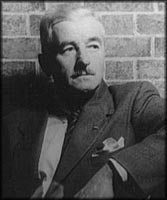 |
||
  |
||
|
|
Faulkner's As I Lay Dying: Images of Faulkner and the SouthLesson One of the Curriculum Unit: Faulkner's As I Lay Dying: Form of a FuneralGuiding Questions
Learning ObjectivesAfter completing the lessons in this unit, students will be able to:
Preparing to Teach this LessonReview the curriculum unit overview and the lesson plan. Locate and bookmark suggested materials and other useful websites. If necessary, download and print out any documents you will use and duplicate copies as necessary for student viewing.ActivityUsing the following websites, students will (preferably in groups) explore one aspect of or perspective on Faulkner's life and the culture of the South. Students should explore the webpage in detail and then write a brief summary of what they discover. If there are images on the website, students should also analyze them—what kind of image is it (graph, photograph, etc.) and what does it reveal about the subject? What does it obscure? The Document Analysis Worksheets, available via EDSITEment reviewed NARA Digital Classroom, might aid in this process.Questions that students might want to consider:
Web Links:
Allow each group to offer a perspective, writing the information on a black board. After all groups have presented, you should have a list of different "perspectives." Discuss them and put them in the context of Faulkner's life and work. This activity serves two purposes. First, the fact finding aspect simply educates students about Faulkner's life, as well as some history of the South. Secondly, and equally importantly, the teacher can use this opportunity as an introduction to the idea of multiple perspectives or points-of-view in describing the life of one person. They are creating a narrative of Faulkner just as many perspectives help shape the narrative of Addie Bundren and her family. Finish by reviewing the quotation by Evan Goodwin at the beginning of this lesson: [Faulkner] often told his stories using multiple narratives, each with their own interests and biases, who allow us to piece together the 'true' circumstances of the story, not as clues in a mystery, but as different melodies in a piece of music that form a crescendo. The conclusion presents a key to understanding the broad panorama surrounding the central event in a way that traditional linear narratives simply are unable to accomplish.Discuss how Faulkner's As I Lay Dying, like history, can be made up of sometimes competing or confusing bits of knowledge, based on the perspective of the viewer. AssessmentAsk students to maintain a journal while reading As I Lay Dying, where they can write down thoughts, questions, and ideas about the novel. They should be sure to include page numbers to relevant passages in the text. Their first entry can explore the following question: what makes "the South" a compelling literary setting? Next LessonReturn to curriculum unit overview—Faulkner’s As I Lay Dying: Form of a FuneralSelected EDSITEment WebsitesInternet Public Library [http://www.ipl.org/]
American Memory
American Studies at the University of
Virginia
[http://xroads.virginia.edu/~DRBR/REED/tears.html] [http://docsouth.unc.edu/index.html]
Standards Alignment View your state’s standards |
||||||||||||||||||||||||||||||||||||||||||||||||||||||||||||||||
  |
||
| EDSITEment contains a variety of links to other websites and references to resources available through government, nonprofit, and commercial entities. These links and references are provided solely for informational purposes and the convenience of the user. Their inclusion does not constitute an endorsement. For more information, please click the Disclaimer icon. | ||
| Disclaimer | Conditions of Use | Privacy Policy Search
| Site
Map | Contact
Us | ||
